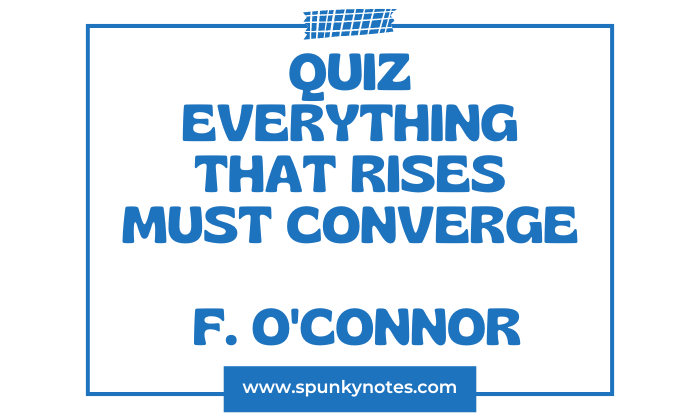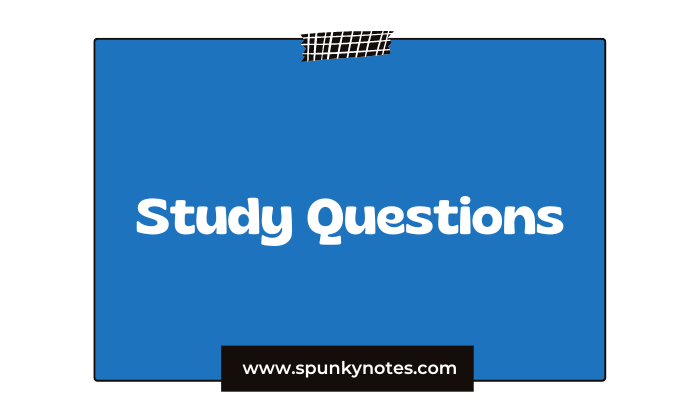
🡆 Before you begin the quiz, read the summary of Everything That Rises Must Converge by Flannery O’Connor.
Everything That Rises Must Converge MCQs
1. Why did Julian’s mother need to lose twenty pounds?
A. She was preparing for a formal dance.
B. Her doctor told her to for her blood pressure.
C. Julian had insisted on her losing weight.
D. She wanted to fit into her old clothes.
2. Where was the reducing class held that Julian had to take his mother to every Wednesday night?
A. The local community centre.
B. The church basement.
C. At the Y, downtown on the bus.
D. A private gym.
3. Why did Julian’s mother insist that Julian accompany her on the bus at night?
A. She disliked waiting for the bus alone.
B. She would not ride integrated buses by herself.
C. Julian was required to sign her in.
D. Julian enjoyed the ride downtown.
4. How did Julian visualize himself while waiting for his mother to finish putting on her hat?
A. A busy executive ready for work.
B. Like Saint Sebastian waiting for arrows.
C. A patient son offering silent encouragement.
D. A king on his throne.
5. What was the physical description of Julian’s mother’s hat?
A. Entirely white with small flowers.
B. A purple and green velvet flap hat.
C. Simple black felt.
D. A jaunty red cap.
6. What was Julian’s general reaction to everything that gave his mother pleasure?
A. He shared in her happiness.
B. It was small and depressed him.
C. He felt indifferent.
D. He thought it was necessary for her health.
7. Why did Julian’s mother insist they “did well” to have an apartment in their neighborhood?
A. The neighborhood had been fashionable forty years ago.
B. The rent was extremely cheap.
C. It was close to Julian’s job.
D. It had been recently renovated.
8. What was Julian’s mother’s response to Julian saying people on the bus didn’t care who she was?
A. I care who I am.
B. That is insulting.
C. You are probably right.
D. They should care who I am.
9. According to Julian’s mother, who was Julian’s great-grandfather?
A. A world-famous general.
B. A former governor of this state.
C. A senator in Washington.
D. A wealthy merchant.
10. What family connection did Julian’s mother mention when asserting their identity?
A. His grandmother was a Godhigh.
B. His uncle was a doctor.
C. His grandfather was a judge.
D. They were related to the president.
11. According to Julian’s mother, how were the slaves owned by her ancestors “better off”?
A. She did not elaborate.
B. They had better housing.
C. She said, “They were better off when they were.”
D. They received an education.
12. What was Julian’s mother’s inevitable conclusion regarding racial integration?
A. They should rise on their own side of the fence.
B. They should be completely equal immediately.
C. They should be encouraged to move into white neighbourhoods.
D. Integration should be gradual.
13. When Julian put his tie back on after his mother protested, what did he mutter to himself?
A. Ready for war.
B. Restored to my class.
C. A complete fool.
D. Never again.
14. Julian insisted culture was in the mind, but his mother maintained culture was where?
A. In tradition.
B. In the heart, and in how you do things.
C. In one’s financial standing.
D. In one’s name.
15. Julian spent most of his time withdrawn into what psychological space?
A. His memories of the old house.
B. The inner compartment of his mind.
C. A dream of future success.
D. Deep contemplation of literature.
16. Julian concluded that if his mother had started from the right premises, more might have been expected of her, but she lived according to the laws of what?
A. Southern etiquette.
B. Financial necessity.
C. Her own fantasy world.
D. Strict morality.
17. What action did Julian take immediately after his mother whispered her concern about riding integrated buses?
A. He asked the driver to stop.
B. He crossed the aisle to sit near the Negro man.
C. He loudly argued with her.
D. He moved to the very back of the bus.
18. What did Julian want to talk to the Negro man about, which would be above the comprehension of those around them?
A. Art or politics.
B. The weather and local news.
C. Real estate investments.
D. Julian’s writing career.
19. Julian realized his mother’s face was unnaturally red, and he allowed no glimmer of sympathy to show because he wanted to desperately keep the advantage and do what?
A. Make her get off the bus immediately.
B. Teach her a lesson that would last her a while.
C. Impress the other passengers.
D. Make a friend of the Negro man.
20. The ultimate horror Julian fantasized about was bringing home what kind of person?
A. A beautiful suspiciously Negroid woman.
B. A loud, aggressive man.
C. A white communist.
D. A poor beggar.
21. How was the large, gaily dressed colored woman who boarded the bus described in terms of her disposition?
A. Happy and welcoming.
B. Sullen-looking and ready to seek opposition.
C. Quiet and reserved.
D. Exhausted and meek.
22. What realization broke upon Julian “with the radiance of a brilliant sunrise”?
A. That his mother was ill.
B. The vision of the two identical hats.
C. That the bus was integrated.
D. That he finally understood his mother’s pain.
23. When Julian’s mother smiled at the little boy (Carver), Julian noted that it was the smile she used when she was being particularly gracious to whom?
A. Children in general.
B. An inferior.
C. Close relatives.
D. Important acquaintances.
24. What was Julian’s “terrible intuition” as he and his mother prepared to exit the bus at their stop?
A. That he had forgotten his wallet.
B. That the woman would scream at them.
C. That his mother would give the little boy a coin.
D. That he would fall down the steps.
25. What coin did Julian’s mother offer the little boy just outside the bus door?
A. A bright new penny.
B. A dime.
C. A quarter.
D. A dollar bill.
26. How did the huge woman respond to the offering of the penny?
A. She took it graciously and thanked Julian’s mother.
B. She shouted, “He don’t take nobody’s pennies!” and swung her pocketbook.
C. She told the boy to thank the lady.
D. She warned Julian’s mother never to touch her son again.
27. What did Julian accuse his mother’s attacker of representing?
A. Just an uppity Negro woman.
B. The whole colored race and her “black double.”
C. A victim of poverty.
D. A psychotic criminal.
28. In her moment of collapse and confusion, what two figures from her past did Julian’s mother ask for?
A. Her doctor and Julian.
B. The bus driver and the woman.
C. Grandpa and Caroline.
D. Her husband and her sister.
29. What was Julian’s mother’s definition of “winning” the struggle of her life?
A. She had successfully raised Julian and sent him to college.
B. That she had married well.
C. That she finally lost twenty pounds.
D. That she had saved the old house.
30. What was Julian’s realization as he ran for help after his mother collapsed?
A. That he truly loved his mother.
B. That he needed to call a doctor immediately.
C. The tide of darkness closing in is his own dependence and guilt.
D. That the Black woman was responsible.
Brief Overview
Everything That Rises Must Converge tells the story of Julian, a young white man, and his mother during the time of racial integration in the American South. Julian is educated and critical of his mother’s racist beliefs, but he still depends on her financially.
They take a newly integrated bus, where Julian’s mother proudly wears a hat meant to show her social class. She tries to interact kindly with a little Black boy, but her gesture is rooted in condescension rather than respect.
The boy’s mother reacts angrily, hitting Julian’s mother with her purse. After getting off the bus, Julian scolds his mother harshly, trying to make her realize her outdated attitudes.
However, she becomes disoriented and suffers a stroke, leaving Julian helpless as he realizes too late that his moral superiority lacked compassion.
The story is about racism, pride, generational conflict, and the irony of self-righteousness. O’Connor reveals how true moral change requires both justice and empathy.

